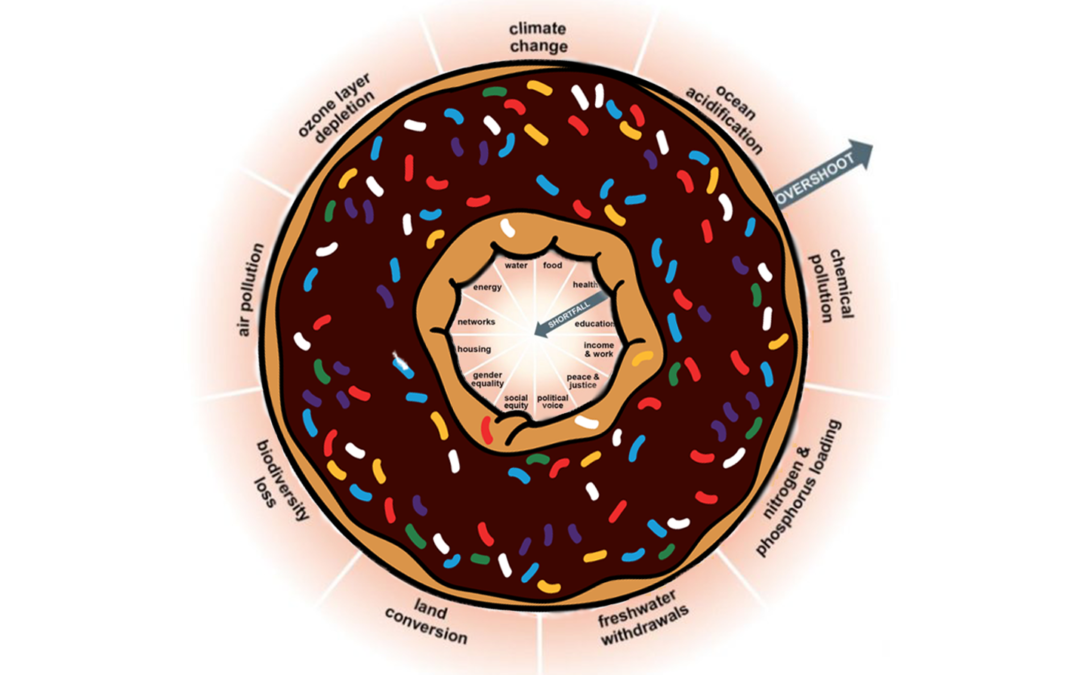For hundreds of years, economic success has been measured by growth. A GDP graph climbing upward shows success, while downturns are signs of trouble. However, Oxford University economist Kate Raworth has designed a new economic success model: the doughnut economy. This economic model strives to create a world where the needs of all people are met under an economic system that considers the ecological needs of the planet. Let’s delve deeper into this fascinating economic theory and its potential application.
Rostow’s Stages of Economic Growth
Modern mainstream economic theory is heavily shaped by the ideas of American economist Walt Whitman Rostow, who in 1960 published an economic model called Rostow’s stages of economic growth.
These five stages of economic growth include:
- Traditional society – Civilizations use barter trading and rudimentary technologies and are heavily dependent on subsistence farming to meet their needs.
- Preconditions for the take-off – Urbanization begins and people start to transition from subsistence farming to commercial farming. Transportation also improves with the construction of roads and railways.
- Take-off – This stage involves development in urbanization, industrialization, and technology.
- Drive to maturity – The industrial base diversifies, and several industries expand as new ones are created. Manufacturing shifts its focus from investment-driven to consumer durables and domestic consumption.
- Age of high mass consumption – The economy is dominated by the industrial base, and consumption of high-value consumer goods (like cars) becomes widespread. Many consumers have disposable income and society becomes heavily urbanized.
Issues with a Growth-Dependent Economy
Kate Raworth has distilled the doughnut economic model into a simple premise: the great challenge of the 21st century will be meeting the needs of all people within the ecological needs of the planet.
Raworth is critical of modern economic theory due to what she says is a failure to address two main concerns: economic inequality and the ecological devastation caused by a growth-at-all-costs economic mentality.
The Oxford economist also posits that the global economy has become addicted—financially, politically, and socially—to growth. Specifically:
- Financial dependence – The modern financial system prioritizes the highest rate of monetary return, which pressures companies to consistently show growth in sales, market share, and profits.
- Political dependence – Politicians often promise economic growth as part of their platforms. In addition, many politicians want to raise tax revenue without raising tax rates and view GDP growth as a way to achieve this goal.
- Social dependence – Consumerism has become one of the defining features of modern culture, and many people with disposable income have an addiction to buying new products.
Doughnut Economics: A Regenerative and Distributive Economy
Raworth’s doughnut economic model is designed to function as a regenerative economy in which wealth is sufficiently distributed so that all humans can enjoy a high standard of living.
She says that the modern global economy is degenerative, as many industries take resources from the planet to create products that are eventually thrown away—sometimes after just a single use. This type of production is pushing the ecological boundaries of the planet and is not sustainable long-term.
To protect the planet from ecological devastation, Raworth believes we will need to shift toward an economy that is instead regenerative by design. In such a system, resources would be reused repeatedly, rather than being thrown out and wasted.
Raworth also characterizes modern economic systems as divisive, as the vast majority of global wealth is highly concentrated among a relative handful of individuals. The doughnut economy would transform the economic system into a more distributive one, in which opportunities are shared equitably.
Social Foundations in the Doughnut Economy
In the doughnut diagram, the inner ring of the image represents the social foundations that should be addressed for all humans to have a quality standard of living.
These foundations were inspired by the Sustainable Development Goals of the United Nations and include the following:
- Food security
- Health care
- Education
- Employment and income
- Social equity
- Gender equality
- Housing
- Peace and justice
- Political voice
- Water
- Energy
- Networks
Addressing Ecological Ceilings in the Doughnut Economy
According to the doughnut economic framework, the social foundations must be addressed while remaining within the following nine ecological ceilings:
- Climate change
- Ocean acidification
- Chemical pollution
- Nitrogen and phosphorous loading
- Freshwater withdrawals
- Land conversion
- Biodiversity loss
- Air pollution
- Depletion of the ozone layer
These categories make up the outer edge of the doughnut economy diagram. Doughnut economics is essentially about finding the balance between providing all humans with a comfortable standard of living while conserving the planet as much as possible.
7 Ways to Practice Doughnut Economics
So, how should businesses approach the transition from a degenerative and divisive economy to a regenerative and distributive system? Raworth has identified the following seven areas of focus:
- Embrace the 21st-century goal of meeting the needs of people within the means of the planet.
- Have a big-picture perspective that considers the company and the planet.
- Promote diversity, collaboration, and participation.
- Think in terms of systems by experimenting, learning, adapting, evolving, and aiming for new goals.
- Be distributive by sharing value with all who worked to create it.
- Be regenerative by working within the ecological needs of the planet.
- Prioritize thriving rather than growth.

